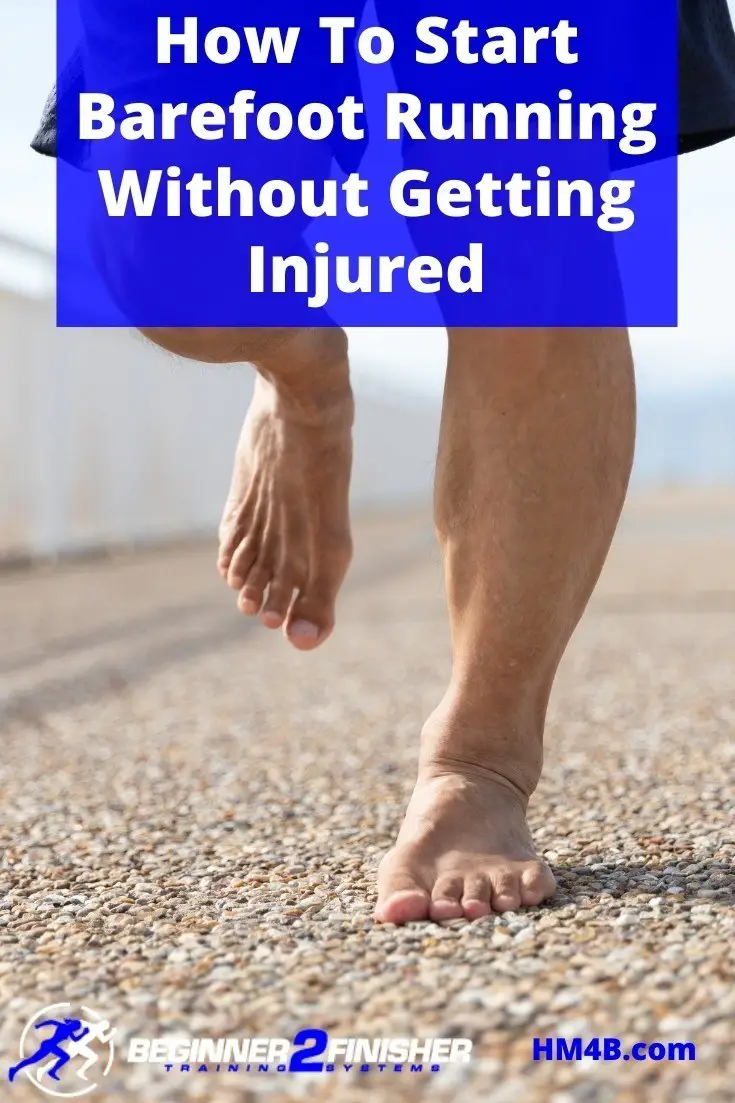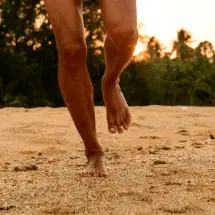If you’d like to start running barefoot without injury, you’ve come to the right place. The best way to avoid getting hurt is to learn proper technique, transition to barefoot running gradually, and keep your Achilles and calves well-stretched at all times.
Even though it started out as a fad or a trend, running barefoot has now become the preferred method for many runners these days. Still, going from using running shoes to running barefoot can raise your risk of injury if you’re not doing it correctly.
In this article, we’re going to cover everything you need to know about running barefoot and whether or not it’s the right choice for you. On top of that, we’ll even share tips with you on how to embrace barefoot running in the safest way possible.
Does Running Barefoot Cause Injuries?
No matter what side of the debate you’re on, the truth is that barefoot running does have its fair share of injury risk, just like regular running does. Proponents might say that barefoot running makes feet more resilient, while others claim that it causes more injuries than usual.
There are several kinds of injuries that you can face when running barefoot. They include a strain of the Achilles tendon, tendonitis, metatarsal fractures, or even metatarsalgia.
Besides that, barefoot running also involves the risk of common running injuries such as friction injuries, blisters, and abrasions.
Does Barefoot Running Prevent Injuries?
No, barefoot running does not prevent injuries. It’s a myth that this running style can reduce the risk of injury in any way.
Some proponents of barefoot running might claim that it prevents injuries because of the difference in running styles. Supposedly, running barefoot encourages people to adjust their running technique and land with their toes down. As a result, people naturally cushion their own landing and reduce the impact.
By landing on with your toes pointed down on each stride instead of your midsole causes the shock of the impact to transfer to the muscles on the back of the leg. Overall, there’s less force involved, and some believe that helps prevent injuries when running barefoot.
Is Barefoot Running Good Or Bad?
Barefoot running is not inherently good or bad. Just like regular running, it has its fair share of pros and cons that you should think about carefully before you try it out.
For example, on the positive side of things, barefoot running can:
- Make you feel more connected to the ground that you’re running on.
- Help you improve your balance since there’s nothing between you and the ground.
- Force you to be more mindful of your running technique.
- Strengthen your feet overall.
While those are some excellent benefits on offer, barefoot running also comes with drawbacks that you must be aware of, including:
- Adjusting to running without shoes is awkward at first.
- No protection or padding for your feet as you run.
- There’s a higher chance of you getting blisters.
- There’s a higher chance of strain or injury to your Achilles, calf muscle, or plantar fasciitis.
As you can see, barefoot running is neither a good nor a bad style of running. As with many things in life, it all boils down to your personal preference.
What’s suitable for one runner may not be the same for another!
How Long Does It Take To Adjust To Barefoot Running?
Transitioning to barefoot running can take three weeks or longer. That’s true whether you’re a beginner or a highly-conditioned marathon runner.
But why? Well, it’s because learning how to run barefoot is an entirely different challenge by itself. The process involves learning and applying a running technique that is very different from what you may already be used to. Plenty of practice is necessary before that technique becomes second-nature.
Besides that, a lot of your time will be spent on rest and recovery. That’s right! You won’t be able to run every day unless you want to face a higher risk of injury. So, you’ll need to have rest days between each barefoot run.
That will ensure that your joints and muscles have enough time to repair themselves as your body adjusts to this brand new way of running.
An average of three weeks might seem like a long time. However, if you’re consistent and focused, that time may be shorter for you. Plus, once you’ve already adapted and internalized the techniques necessary to run barefoot, those skills will stay with you for life.
Best Running Tips For Beginner Barefoot Runners?
If you’re new to barefoot running, here are a few timeless tips that you’ll want to keep in mind at all times:
- If it hurts, stop – There’s a fine line between pushing your body to its limits and doing something detrimental. So, if at any time you feel like barefoot running is hurting you, you must stop immediately. Double-check that your technique is correct or allow for more recovery time.
- Transition slowly – When switching from conventional to barefoot running, you must do so gradually. This transition is a great shock to your body, especially your legs. Only do a little bit each time, and increase the duration of your barefoot run gradually.
- Listen to your body – You’ve probably heard this often already. Still, it’s true, especially with barefoot running. Be mindful of how your body feels when running barefoot. If you think you need to slow down and take a break, do it!
- Stretching is critical – Barefoot running places additional stress on parts like your Achilles tendon and your calves. Always be sure to stretch these and other muscles often, especially before and after your barefoot run.
- Remember basic running principles – Sure, you’re focusing on your barefoot running technique. But don’t neglect basic running principles like staying hydrated and practicing proper breathing techniques as well!
There are plenty of barefoot running tips and tricks that you’ll discover along your journey. Still, these five should provide a solid foundation that you can use to start your journey.
Barefoot Running Technique
As you might imagine, you’ll need to change your technique when switching from regular to barefoot running. Here are some of the things you’ll want to keep in mind to ensure that your technique is ideal for safe and efficient barefoot running.
- Keep your strides short. That means reducing how far you stretch your leg out, almost to mimic the same stride you’d use if you were running in place.
- Stay upright and balanced (i.e. without leaning forward) by ensuring that your feet are under your shoulders and hips.
- When landing each step, land on the balls of your feet and not your heels. Shorten your stride until that becomes possible.
- Your step should be a bit more ‘springy’. That’s to keep yourself running light without excessive impact on your feet as they come into contact with the ground.
- Try and run ‘silently’. When you deliberately try to run without making too much noise with each step, you’ll naturally implement the steps mentioned above.
How To Transition To Barefoot Running
The transition period from conventional to barefoot running must be slow and gradual. Your patience is the most important aspect of this process.
Here’s what that process should look like:
- Don’t do an entire barefoot run immediately. Instead, start by running for just a few minutes each time without any shoes on. This should be done only on a hard surface because soft surfaces may be too challenging for your muscles at this point.
- With each passing day, extend your barefoot running sessions, but only by a few minutes at a time. That will give your joints and muscles plenty of time to adjust and recover accordingly.
- Only when you feel comfortable and confident in your progress can you start to go on short barefoot runs. The emphasis here is on ‘short’. We can’t stress this enough: your progress must be slow to lower the risk of injury.
- After you’ve completed ten or so barefoot runs, then you can consider switching to barefoot running as your primary method.
- Another level up would be to run barefoot on softer surfaces. Surfaces like grass and sand provide less support for your feet and arches, making it much more challenging on your muscles.
Barefoot Running Stretches
Stretching is incredibly important for any kind of physical activity, including running. However, barefoot running requires that you emphasize certain muscles more than others.
For example, you’ll want to spend more time stretching your calves and your Achilles tendon. These two parts of your feet tend to experience a higher level of stress and tension whenever you’re running barefoot, whether on hard or soft surfaces.
Some popular stretching techniques that will help make your feet more limber include:
- Toe-back stretch.
- Upper-side stretch.
- Slant stretch.
- Ballerina stretch.
Of course, there are plenty of stretches out there available for you to choose from. As long as they focus on the muscles most exerted during barefoot running, then they’ll benefit you greatly. Be sure to perform these stretches during your warmup and your cooldown to keep your muscle at the optimum length.
Why Do You Run Faster Barefoot?
You may have heard that people can run faster when they do so barefoot. Yes, that is true. However, it’s essential to understand why this happens, as the increase in speed isn’t caused just by simply taking your shoes off for a run.
Think of it as a secondary effect. Firstly, when you train yourself to run barefoot, you’re forcing yourself to be more mindful of your running technique. Specific muscles in your feet also become much stronger as a result of running without any shoes on.
There’s one more explanation. Since your feet aren’t covered by running shoes, any force they generate will go straight to the ground. The process becomes more efficient overall, making you run at a faster speed.
Should You Run Barefoot All The Time When Running?
No, even if barefoot running is your preferred method, it would not be wise to run that way all the time. Remember: all forms of running have their fair share of pros and cons, including barefoot running.
Rather than spend all of your time barefoot running exclusively, it would be better to mix it up once in a while. That way, you can be a more well-rounded runner who enjoys the benefits of both worlds.
For example, running barefoot will make you more mindful of your running technique while strengthening your feet and legs’ muscles. Running will shoes will provide more padding and less impact, allowing you to give your feet a break from time to time while still maintaining a consistent running schedule.
References
https://www.foothealthfacts.org/conditions/barefoot-running
https://www.trainingpeaks.com/blog/how-to-safely-transition-to-barefoot-running/

